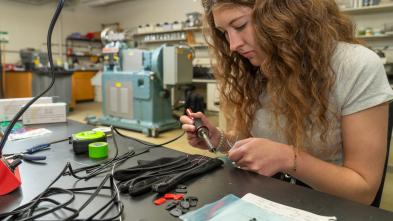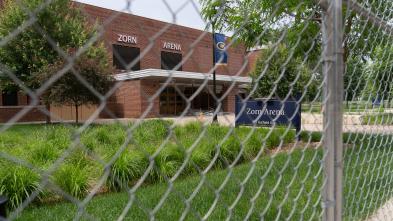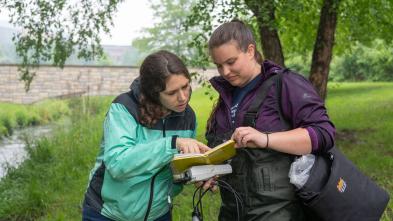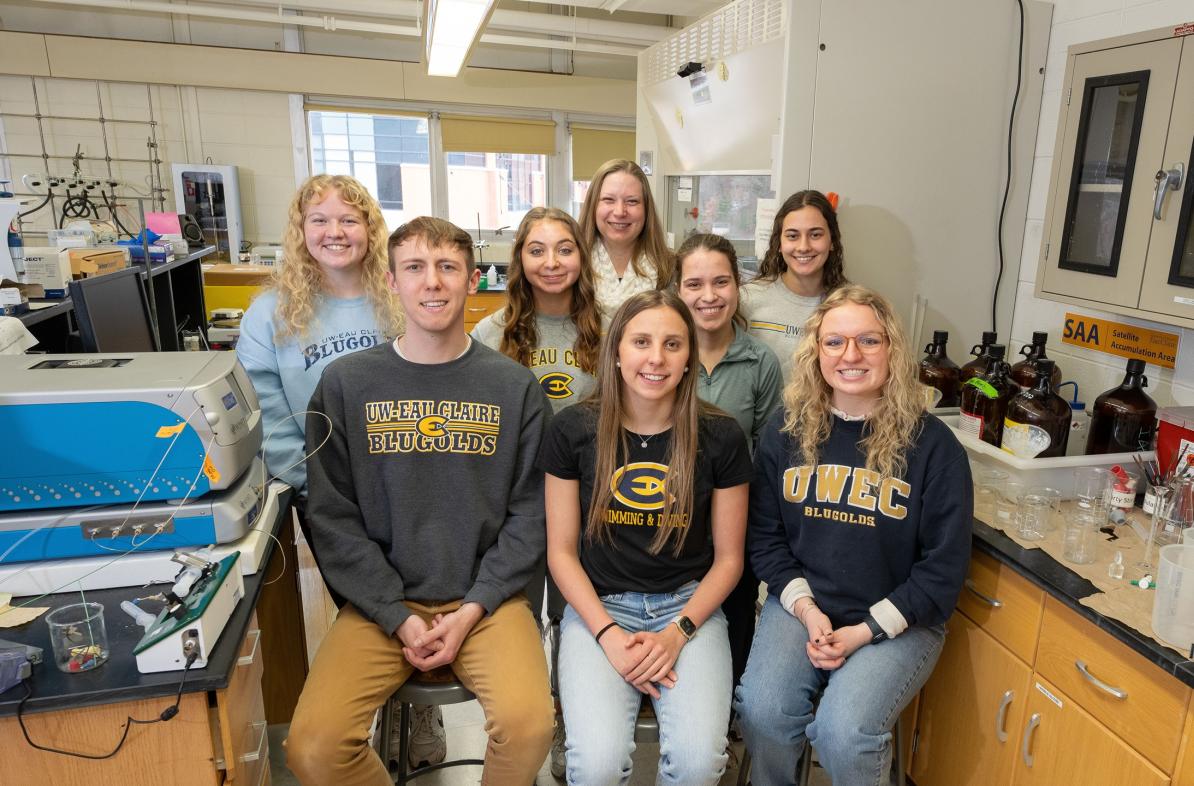
Q&A with our foam research team
One of the notable aspects of collaborative student-faculty research at the University of Wisconsin-Eau Claire is that the many ongoing faculty-led projects allow students to return to a project for multiple years. This enhances both their growth as researchers and their knowledge of the topics.
For the team of eight students who spent the last academic year in the research lab with Dr. Elizabeth Glogowski, Ramsey research professor of materials science and biomedical engineering, the quest to develop a groundbreaking medical-use foam has been an incredible experience for everyone involved.
This lab team also is unique because all students on the team, first- through fourth-year students, are Blugold Biomedical Innovator Scholars. The project has been conducted in collaboration with Dr. Jeremy McBride, an interventional radiologist at Mayo Clinic Health System-Eau Claire.
Glogowski and her research team agreed to answer a few questions about their project and give a glimpse into the experience of this intensive scientific research through the lens of students at all levels of student experience.
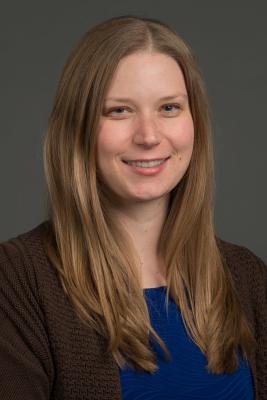
Can you give a recap of the overall project from its initial stages to now, and share what is next for the project?
This project started in 2019 when Dr. McBride approached us in materials science and biomedical engineering with a research idea — a new material that could be used during tumor ablation procedures which could improve outcomes for cancer patients. He needed a product that would better protect healthy organs and tissues during these extreme freezing and heating treatments of cancerous tumors.
We’ve created a foam that can be injected at the site to separate the cancerous tissue from the healthy tissue. It will insulate the healthy tissue and dissipate once the procedure is done. All materials used are FDA approved. We have had great success in the lab developing and testing these foams, and we are planning next steps of testing the foam with patients.
Dr. McBride and I always have new ideas for what to try next. Here at UWEC, we are focusing on analyzing the data for peer-reviewed publication. We are also developing methods to simplify commercialization of foam preparation and distribution. Dr. McBride is focused on the process for getting a clinical trial approved.
Describe the growth and opportunities your research students have experienced, both in and out of the laboratory.
None of this research would be possible without the students. The students are the ones in the lab, making foams, optimizing procedures, collecting data and testing different variables and additives to make the foams “just right.”
The Biomedical Innovator Scholars program is one of only two campus programs that puts first-year students on a research project from the first day they arrive on campus. In addition to all they have accomplished with the foam itself, my research students have presented at Posters on the Hill in Washington, D.C., UWEC’s Celebration of Excellence in Research and Creative Activity (CERCA) and presented to top Mayo and Universities of Wisconsin officials, including Gov. Tony Evers.
Having research experience so early in their careers gives students hands-on experiences in their areas of interest specific to their careers. Research lets students use their classroom knowledge in a very applied and real-world way. This helps them focus and be confident in their career choices, because they’ve been able to try different things and experience them firsthand.
I am so excited for the students who are graduating, although it is always bittersweet. I’m happy for them, but I’ll miss them as people and for their contributions to the project and the group overall.
First-year Biomedical Innovator Scholars:
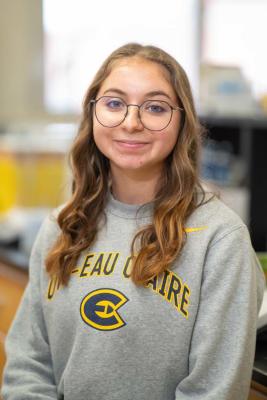
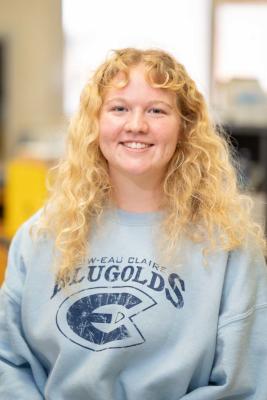
What was it like to be on this journey into biomedical research, and how would you describe the learning curve?
Giallombardo: What I was most nervous about when starting this research was messing up an experiment or not understanding all the information. I quickly learned that absolutely everyone makes mistakes and sometimes things go wrong more often than they go right. The goal is then figuring out what went wrong so we can troubleshoot it for next time.
Farber: I applied to the biomed program not only to gain exposure to research as a first-year undergraduate student, but I wanted to join a team of students making significant biomedical advances. Coming in, I was worried about the high level of scientific research, but once we all met and started working as a team, I realized I had nothing to worry about.
Biomedical Innovator Scholars can elect to change projects for different experiences or remain in the same group. After one year of research, which way are you leaning on that decision?
Giallombardo: I would love to continue on this project. I feel like I am finally getting into the groove of things and want to follow it through. Dr. G. is an amazing research professor. She provides valuable support every step of the way. I am so grateful for her patience and the opportunity to work under her mentorship.
Farber: As of now, I want to stay on this project longer. As a first-year researcher, I feel as though I am just understanding the flow of the work on this team, and I am fascinated by the project. The science behind the foam related well to my major, and I am enjoying exploring it and expanding my knowledge.
Second- and third-year scholars:
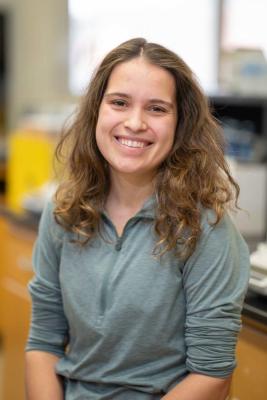
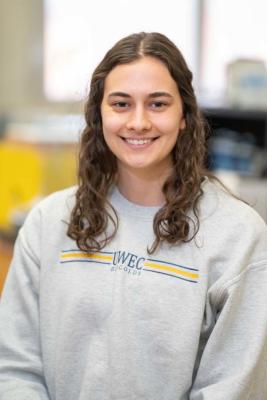
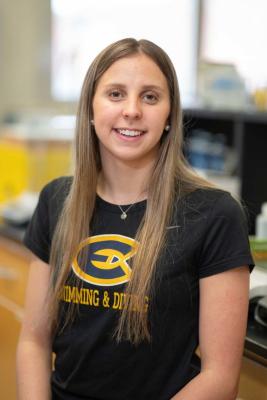
How would you describe the transition from that first year of unknowns to where you are now as a student researcher?
Smith: I think with the Biomedical Innovators program, because we start research so early on, sometimes even before we've even completed a college-level lab course, it can be very intimidating. It was reassuring that Kira Haus and Marshall Apps were the ones to train me because I knew they had been in my shoes just a year prior, yet they seemed so confident teaching me.
Sure enough, one year later I found myself teaching new students with the same confidence.
Jiter: This is my first year on this project; my first project was in a different lab. So, this year has been a lot about learning the specifics of this project, getting caught up on what findings have been made so far and what directions we are moving from there.
Overall, being able to converse and work with other people on the foam research team has helped me feel more settled into the undergrad research world because I can learn from their experiences, and they can give me guidance on different aspects of our work.
Has this scholarship and program lived up to the word “Innovators” in the name?
Smith: The program certainly lives up to the term "innovator" to me. The program really is one of a kind and has opened so many doors for me and my peers. Along with the research opportunities available to BI's, we have had lots of cool opportunities like a Mayo-hosted procedural skills clinic once a semester that was initially only open to medical and physician assistant students. Mayo Clinic Health System has been great, offering us unique educational opportunities and the chance to learn more about the health care field.
Jiter: The therapeutic foams research is novel and innovative research. Collaborating with a Mayo Clinic researcher like Dr. McBride is the kind of opportunity that is not available to undergraduate students in many other places. We can see the practical application and how our research can be beneficial to people, which I think also makes it feel like real innovation is happening.
Graduating seniors:
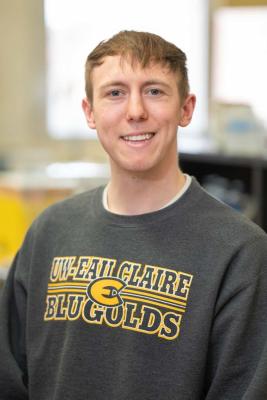
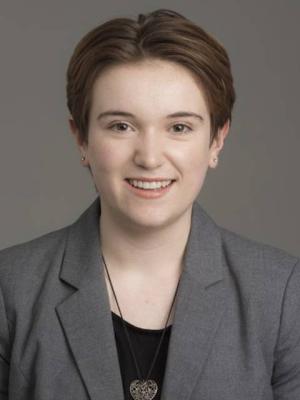
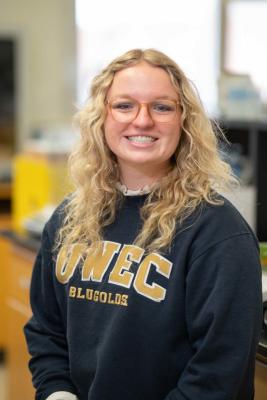
Did you always plan to stay on the same project all the way through your program? What advantages did it give you to have worked on the same research for the whole program?
Apps: Once I really understood what this foam project was about, I knew it would be fascinating to remain as long as I could. By no means am I an expert, but after four years, I have developed substantial knowledge of working in an undergraduate lab and specific knowledge on tumor ablation, foam creation and what all goes into undergraduate research.
Cunningham: It was rewarding to see some of the longer-term results of my work when staying on the project for all of my time. I also developed close relationships with other researchers and with Dr. Glogowski, which have been incredibly valuable.
What do you see as the major project milestones achieved by your team?
Apps: A major step in the process was finally establishing the exact combination of materials and best method for creating the foam. That was an exciting hurdle to clear. That cleared the way for our Mayo collaborator, Dr. McBride, to begin using the foam for in-vivo porcine studies.
Haus: Marshall and I attended the Academic Grand Rounds research event with Mayo Clinic Health System, where we described our research project to clinicians. While it was daunting, I felt incredibly respected by everyone who attended, and they were intrigued by our project.
Another presentation Marshall and I did was called Posters on the Hill, a Washington, D.C., event through the National Council on Undergraduate Research (NCUR), where we presented to Wisconsin legislative representatives about our project and the significance of undergraduate research to a successful college career.
This will remain an ongoing research project, as you know. What will you miss about this team and seeing the realization of the hopes for the foam product?
Apps: I will for sure miss being part of the foam team. Although I won’t be able to see its use in human trials and clinical use, knowing that I was a part of this project that will eventually reach those steps is still very exciting. The current students on the project have already made excellent progress and I know they will continue to do so, and hopefully soon they can see the project race over the finish line.
Cunningham: I will miss being part of this team. I plan to check in and see where things are with the project down the road, and keep an eye out for any updates. In a sense, however, research is never really done, so it comes with the territory. There’s always more to discover and more to learn. Overall, it's just rewarding to know that I was able to be a part of it and others will continue furthering our important work.
Haus: While I am sad to complete my time on the “foam team,” I have the utmost confidence that the younger students will keep making progress and make me proud. As I know research is an ongoing process and it’s never ending, I feel that I will be chasing results for the rest of my career. I’m proud to say I’ve made some impact on this novel project; working on something that will eventually help people feels amazing.
What would you say are the most lasting lessons you will take from your time among the first-ever Blugold Biomedical Innovator Scholars?
Apps: I’ve learned so much from Dr. Glogowski, like critical problem-solving. Looking systemically at a problem like a failed experiment is a great skill that I’ve brought into working in my biology and chemistry labs, as well as just thinking things through logically in my life.
My time in this lab has also taught me leadership. There have been many new researchers in the lab, and I have enjoyed guiding them into the work we do. It has been great to see how they evolve as researchers and really come into their own on the team.
Cunningham: The biggest lesson I've learned is how to confidently bounce ideas back and forth with peers. Dr. Glogowski has been fantastic at providing supported learning but letting us work together and brainstorm, and bring our own skills and ideas to the table.
Haus: I have gained significant skills in public speaking and communicating scientific work to a variety of audiences, assets that will be important in my career. But one bigger lesson stands out for me.
Dr. G. told us that we should always say yes to new opportunities, and not be afraid to try something new, even when we are not certain we know how. That is a lesson I will carry into my biomedical industry career. Saying yes to this research got me interested in a biomedical engineering career in the first place.
You may also like
